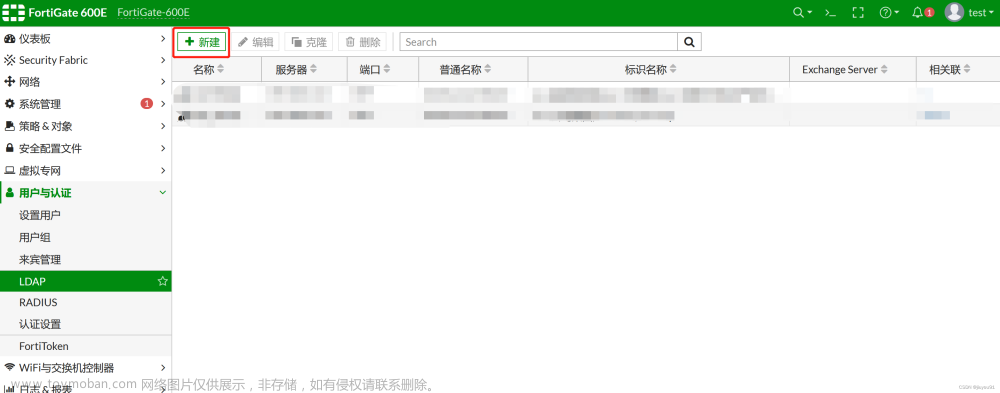LADP概述
LDAP(轻量目录访问协议)是一种用于访问和维护分布式目录信息服务的协议。目录服务是一种存储和检索信息的服务,通常用于存储组织内的用户信息、组织结构、网络设备等数据。LDAP是一种轻量级的协议,设计用于在目录中进行查找和修改操作,而不是用于传输大量的数据。
以下是LDAP的一些基本概念:
目录服务(Directory Service): 目录服务是一种专门设计用于存储和检索信息的服务。与传统数据库不同,目录服务更注重提供高效的读取操作,支持快速的数据检索。LDAP是一种协议,用于与目录服务进行通信。
目录(Directory): 目录是一种组织结构化数据的方式,通常包含多个条目(Entry)。每个条目包含一组属性值,用于描述特定实体(如用户、组织单位、设备等)的信息。
条目(Entry): 条目是目录中的基本单位,类似于数据库中的一行记录。每个条目都有一个唯一的标识符,称为DN(Distinguished Name)。
属性(Attribute): 属性是条目中存储的信息的命名和值对。例如,一个用户条目可能包含属性如姓名、电子邮件地址、电话号码等。
DN(Distinguished Name): DN是每个条目在目录中的唯一标识符,由一系列与目录结构相关的名称组成。DN通常是一个层次结构,例如"cn=john,ou=users,dc=example,dc=com"。
LDAP协议: LDAP定义了客户端和目录服务器之间进行通信的规则。它使用TCP/IP协议栈,通常在389端口上运行。LDAP协议支持多种操作,包括搜索、添加、删除、修改等,以便对目录中的数据进行操作。
LDAP被广泛用于企业和组织中,用于集中管理用户、组织结构、设备等信息。它是许多身份验证和访问控制系统的基础,如单点登录(SSO)系统。
步骤一:配置LDAP连接属性:
在application.properties或application.yml文件中添加LDAP连接属性,例如LDAP服务器URL、用户名、密码等。
步骤二:创建LDAP配置类:
创建一个@Configuration类,并使用@EnableWebSecurity注解启用Web安全性配置。在配置类中,可以使用LDAP的相关配置属性来配置LDAP连接和认证提供者。
步骤三:创建LDAP认证提供者:
实现UserDetailsService接口并重写其中的loadUserByUsername()方法,要在Spring Boot项目中整合LDAP(轻量级目录访问协议),可以使用Spring LDAP模块。以下是一个简单的示例,展示如何在Spring Boot中整合LDAP,并提供一些常见的操作示例。
整合步骤
1.引入POM依赖
<dependency>
<groupId>org.springframework.boot</groupId>
<artifactId>spring-boot-starter-data-ldap</artifactId>
</dependency>
2.在application.properties或application.yml文件中提供LDAP连接的配置信息
ldap.url=ldap://your-ldap-server:389
ldap.base=dc=example,dc=com
ldap.userDnPattern=uid={0},ou=people
ldap.userSearchBase=ou=people
3.创建LdapDemoConfig
package com.example.springbootidapdemo.config;
import org.springframework.context.annotation.Bean;
import org.springframework.context.annotation.Configuration;
import org.springframework.ldap.core.LdapTemplate;
import org.springframework.ldap.core.support.LdapContextSource;
@Configuration
public class LdapDemoConfig {
@Bean
public LdapTemplate ldapTemplate() {
LdapContextSource contextSource = new LdapContextSource();
contextSource.setUrl("ldap://localhost:389");
contextSource.setBase("dc=example,dc=com");
contextSource.setUserDn("cn=admin,dc=example,dc=com");
contextSource.setPassword("adminpassword");
contextSource.afterPropertiesSet();
LdapTemplate ldapTemplate = new LdapTemplate(contextSource);
ldapTemplate.setIgnorePartialResultException(true);
ldapTemplate.setDefaultTimeLimit(1000);
ldapTemplate.setDefaultCountLimit(100);
return ldapTemplate;
}
}
4.方法概述及对应Demo
前提:需要提供基础DN、过滤器、搜索控件和属性映射器。实际使用时,需要根据LDAP目录的结构和属性进行相应的配置。
1.ldapTemplate.find(根据指定的搜索条件在LDAP目录中查找条目并返回结果)
public <T> T find(
String dn,
String filter,
SearchControls controls,
AttributesMapper<T> mapper)
dn: 搜索的基础DN(Distinguished Name),表示搜索的起始位置。filter: LDAP搜索过滤器,定义要匹配的条目的条件。controls: 搜索控件,用于配置搜索的一些参数,例如搜索范围、返回的属性等。mapper: 用于将搜索结果映射为对象的 AttributesMapper。
该方法会执行LDAP搜索并返回满足条件的第一个条目。如果没有匹配的条目,返回 null。
Demo如下:文章来源:https://www.toymoban.com/news/detail-751776.html
@Service
public class LdapService {
@Autowired
private LdapTemplate ldapTemplate;
public User findUser(String username) {
String baseDn = "ou=people,dc=example,dc=com";
String filter = "(uid=" + username + ")";
SearchControls controls = new SearchControls();
controls.setSearchScope(SearchControls.SUBTREE_SCOPE);
return ldapTemplate.find(baseDn, filter, controls, new UserAttributesMapper());
}
private static class UserAttributesMapper implements AttributesMapper<User> {
@Override
public User mapFromAttributes(Attributes attributes) throws NamingException {
return new User(/* user properties */);
}
}
}
下述demo只展示关键代码块、重复描述不再过多赘述
2.ldapTemplate.findAll(根据指定的搜索条件在LDAP目录中查找多个条目并返回结果列表)
public <T> List<T> findAll(
String base,
String filter,
SearchControls controls,
AttributesMapper<T> mapper)
base: 搜索的基础DN(Distinguished Name),表示搜索的起始位置。
该方法会执行LDAP搜索并返回满足条件的所有条目的列表。如果没有匹配的条目,返回空列表。
Demo如下:
public List<User> findAllUsers() {
String baseDn = "ou=people,dc=example,dc=com";
String filter = "(objectClass=person)";
SearchControls controls = new SearchControls();
controls.setSearchScope(SearchControls.SUBTREE_SCOPE);
return ldapTemplate.findAll(baseDn, filter, controls, new UserAttributesMapper());
}
3.ldapTemplate.findOne(根据指定的搜索条件在LDAP目录中查找单个条目并返回结果)
注意:如果没有匹配的条目,抛出 javax.naming.NameNotFoundException 异常。如果有匹配的多个条目,抛出 javax.naming.NamingException 异常
public <T> T findOne(
String dn,
String filter,
AttributesMapper<T> mapper)
Demo如下:
public User findUser(String username) {
String baseDn = "ou=people,dc=example,dc=com";
String filter = "(uid=" + username + ")";
return ldapTemplate.findOne(baseDn, filter, new UserAttributesMapper());
}
4.ldapTemplate.findByDn(根据给定的DN(Distinguished Name)查找单个条目并返回结果)
public <T> T findByDn(String dn, AttributesMapper<T> mapper)
该方法会执行LDAP搜索并返回指定DN的条目,如果没有找到匹配的条目,返回 null。
Demo如下:
public User findUserByDn(String userDn) {
return ldapTemplate.findByDn(userDn, new UserAttributesMapper());
}
5.ldapTemplate.findForStream(用于从 LDAP 目录中以流的方式获取多个条目的结果)
public <T> Stream<T> findForStream(
String base,
String filter,
SearchControls controls,
AttributesMapper<T> mapper)
ldapTemplate.findForStream方法会执行LDAP搜索并返回一个流(Stream),其中包含满足条件的所有条目的结果。通过使用流的方式,可以更高效地处理大量的搜索结果,而不必一次性将所有结果加载到内存中。
Demo如下:
public List<User> findAllUsers() {
String baseDn = "ou=people,dc=example,dc=com";
String filter = "(objectClass=person)";
SearchControls controls = new SearchControls();
controls.setSearchScope(SearchControls.SUBTREE_SCOPE);
Stream<User> userStream = ldapTemplate.findForStream(baseDn, filter, controls, new UserAttributesMapper());
return userStream.collect(Collectors.toList());
}
注意:ldapTemplate.findForStream 方法是从 Spring LDAP 2.2 版本开始引入的。确保使用的是兼容的 Spring LDAP 版本。如果版本较旧,可能需要升级到兼容的版本或者使用其他方法来处理 LDAP 搜索结果流
6.ldapTemplate.search(用于执行灵活的LDAP搜索并返回结果)
public <T> List<T> search(
String base,
String filter,
SearchControls controls,
AttributesMapper<T> mapper)
与之前介绍的
ldapTemplate.findAll方法相似,ldapTemplate.search方法也执行LDAP搜索,但它提供更多的灵活性,可以更精确地配置搜索参数。该方法返回满足条件的所有条目的列表。
Demo如下:
public List<User> searchUsers(String filter) {
String baseDn = "ou=people,dc=example,dc=com";
SearchControls controls = new SearchControls();
controls.setSearchScope(SearchControls.SUBTREE_SCOPE);
return ldapTemplate.search(baseDn, filter, controls, new UserAttributesMapper());
}
7.ldapTemplate.searchForContext(用于执行LDAP搜索并返回搜索结果的上下文(DirContext))
public DirContext searchForContext(
String base,
String filter,
SearchControls controls)
与之前介绍的
ldapTemplate.search方法相比ldapTemplate.searchForContext返回的是搜索结果的上下文,而不是直接返回映射后的对象列表。这样的设计使得可以更灵活地处理搜索结果,包括对搜索结果的进一步处理、解析和操作。
Demo如下:
public DirContext searchForContext(String filter) {
String baseDn = "ou=people,dc=example,dc=com";
SearchControls controls = new SearchControls();
controls.setSearchScope(SearchControls.SUBTREE_SCOPE);
return ldapTemplate.searchForContext(baseDn, filter, controls);
}
8.ldapTemplate.searchForObject(用于执行LDAP搜索并返回单个对象作为结果)
public <T> T searchForObject(
String base,
String filter,
SearchControls controls,
Class<T> requiredType)
requiredType: 期望的返回类型。
该方法执行LDAP搜索并返回单个对象,而不是返回一个对象列表。这可以方便地用于查找特定条件下的唯一条目。
Demo如下:
public User searchForUser(String username) {
String baseDn = "ou=people,dc=example,dc=com";
String filter = "(uid=" + username + ")";
SearchControls controls = new SearchControls();
controls.setSearchScope(SearchControls.SUBTREE_SCOPE);
return ldapTemplate.searchForObject(baseDn, filter, controls, User.class);
}
注意:如果没有找到匹配的条目,ldapTemplate.searchForObject 方法将返回 null
9.ldapTemplate.searchForStream(用于执行LDAP搜索并返回结果的流(Stream))
public <T> Stream<T> searchForStream(
String base,
String filter,
SearchControls controls,
Class<T> requiredType)
该方法执行LDAP搜索并返回一个流(Stream),其中包含满足条件的所有条目的结果。通过使用流的方式,可以更高效地处理大量的搜索结果,而不必一次性将所有结果加载到内存中。
Demo如下:
public List<User> searchForUsers(String filter) {
String baseDn = "ou=people,dc=example,dc=com";
SearchControls controls = new SearchControls();
controls.setSearchScope(SearchControls.SUBTREE_SCOPE);
Stream<User> userStream = ldapTemplate.searchForStream(baseDn, filter, controls, User.class);
return userStream.collect(Collectors.toList());
}
10.ldapTemplate.rebind(用于重新绑定(更新)LDAP目录中的条目)
public void rebind(String dn, Object obj, Attributes attributes)
obj: 要重新绑定的对象。
该方法会将指定的对象和属性重新绑定到LDAP目录中的指定DN。如果指定的DN不存在,则会创建新的条目。如果已存在具有相同DN的条目,则会更新现有条目的属性。
public void updateUserInfo(String userDn, User newUser) {
// Assume User class has appropriate getters and setters for user attributes
Attributes attributes = // create or update attributes based on newUser
ldapTemplate.rebind(userDn, newUser, attributes);
}
注意:具体的 Attributes 对象的创建或更新需要根据您的数据模型和需求进行调整
11.ldapTemplate.rename(用于重命名(移动)LDAP目录中的条目)
public void rename(String oldDn, String newDn)
oldDn: 要重命名的旧DN,表示LDAP目录中的一个条目。newDn: 新的DN,表示条目在LDAP目录中的新位置。
该方法会将指定的条目从旧的DN移动到新的DN,实现重命名的效果。
Demo如下:
public void renameUser(String oldDn, String newDn) {
ldapTemplate.rename(oldDn, newDn);
}
注意:新的DN必须包含新的父级DN,以确保条目被正确移动到新的位置。例如,如果要将用户从 "ou=people,dc=example,dc=com" 移动到"ou=otherPeople,dc=example,dc=com",则新的DN应为"uid=john,ou=otherPeople,dc=example,dc=com"。
12.ldapTemplate.modifyAttributes(用于修改LDAP目录中条目的属性值)
public void modifyAttributes(String dn, ModificationItem[] mods)
mods: 要应用的修改项数组,表示要对条目进行的修改操作。
修改项(ModificationItem)由两个属性组成:修改操作类型(DirContext.ADD_ATTRIBUTE、DirContext.REMOVE_ATTRIBUTE 或 DirContext.REPLACE_ATTRIBUTE)和要修改的属性(Attribute)。
Demo如下:
public void updateUserPassword(String userDn, String newPassword) {
ModificationItem[] mods = new ModificationItem[1];
Attribute attribute = new BasicAttribute("userPassword", newPassword);
mods[0] = new ModificationItem(DirContext.REPLACE_ATTRIBUTE, attribute);
ldapTemplate.modifyAttributes(userDn, mods);
}
上述示例中,
updateUserPassword方法使用了ldapTemplate.modifyAttributes来根据用户DN(userDn)修改用户密码。首先,创建一个ModificationItem数组,包含要进行的修改操作。在这个示例中,它只包含一项:用新密码替换(DirContext.REPLACE_ATTRIBUTE)userPassword属性。然后,将这个修改项数组传递给ldapTemplate.modifyAttributes方法,以便进行修改
13.ldapTemplate.authenticate(用于对LDAP进行认证操作)
public boolean authenticate(String base, String filter, String password)
password: 用户密码,用于认证操作。
该方法用于验证给定的用户密码是否与LDAP中指定条件的用户匹配。如果匹配成功,则返回 true,否则返回 false。
Demo如下:
public boolean authenticateUser(String username, String password) {
String baseDn = "ou=people,dc=example,dc=com";
String filter = "(uid=" + username + ")";
return ldapTemplate.authenticate(baseDn, filter, password);
}
上述示例中,
authenticateUser方法使用了ldapTemplate.authenticate来验证用户的身份。需要提供基础DN、过滤器和用户密码。该方法将验证提供的用户名和密码是否匹配LDAP中指定条件的用户,如果匹配成功,则返回 true,表示认证通过。文章来源地址https://www.toymoban.com/news/detail-751776.html
到了这里,关于SpringBoot整合Ldap--超详细方法讲解的文章就介绍完了。如果您还想了解更多内容,请在右上角搜索TOY模板网以前的文章或继续浏览下面的相关文章,希望大家以后多多支持TOY模板网!













